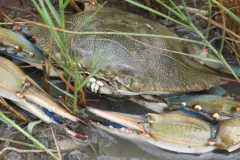A Bite of Bitter Crab

Hopefully you've never bitten into a delicious hunk of snow crab meat and instantly spit it out because instead of crab you tasted... aspirin?! If you have, it might have been crab meat infected with a species of Hematodinium, a parasitic dinoflagellate that is the cause of Bitter Crab Disease in cold-water crab species.
This parasite lowers the “tasty factor” of commercially important cold-water crabs around the world. At present, there are reports of 39 species of crab and shrimp from 12 countries being infected. Recent victims include the snow crab (Chionoecetes opilio), the Norway lobster (Nephrops norvegicus), and the American blue crab (Callinectes sapidus) found on the east coast of the United States and the Gulf of Mexico.
Hematodium was first reported in the United States in 1968, where it was found infecting blue crabs from several areas along the East Coast. The species was believed to be H. perezi (seen in the picture below: the parasite is stained red within blue crab cells), the original parasite species reported from Europe in 1931. However, because it is impossible to tell the difference between species in the genus Hematodium just by looking at them, scientists weren't sure. Finally in 2012, researchers used DNA sequence data to confirm that the species was, in fact, H. perezi—43 years after its first observation! In 2013, scientists confirmed that the same species found in the Chesapeake Bay also infects blue crabs off Georgia, the Gulf Coast of Florida and Texas.
 DNA sequence data also verified that H. perezi infects many other types of crustaceans in addition to blue crabs, including two species of spider crabs, one species of hermit crab, and two species of mud crabs. That makes it a “host generalist:” a parasite that infects a number of different animals rather than specializing in one species.
DNA sequence data also verified that H. perezi infects many other types of crustaceans in addition to blue crabs, including two species of spider crabs, one species of hermit crab, and two species of mud crabs. That makes it a “host generalist:” a parasite that infects a number of different animals rather than specializing in one species.
Why is it important to know whether a parasite has many hosts or just one? The number of hosts in a particular area (a.k.a. the amount of parasite habitat) limits how many parasites can survive. If H. perezi could only survive in blue crabs and they were eliminated or extremely depleted, the parasite would likely be eliminated from the area. But if it can infect and reproduce in many different hosts, the loss of a single host species would not greatly impact the parasite population.
So, it looks like aspirin-flavored crab may be on the menu for quite a while.

